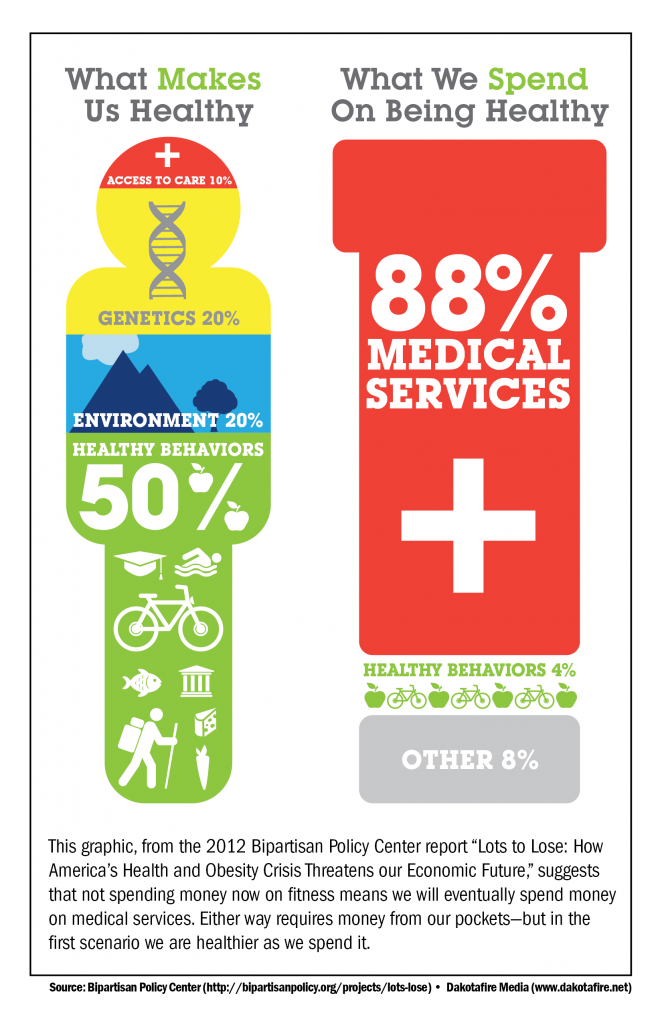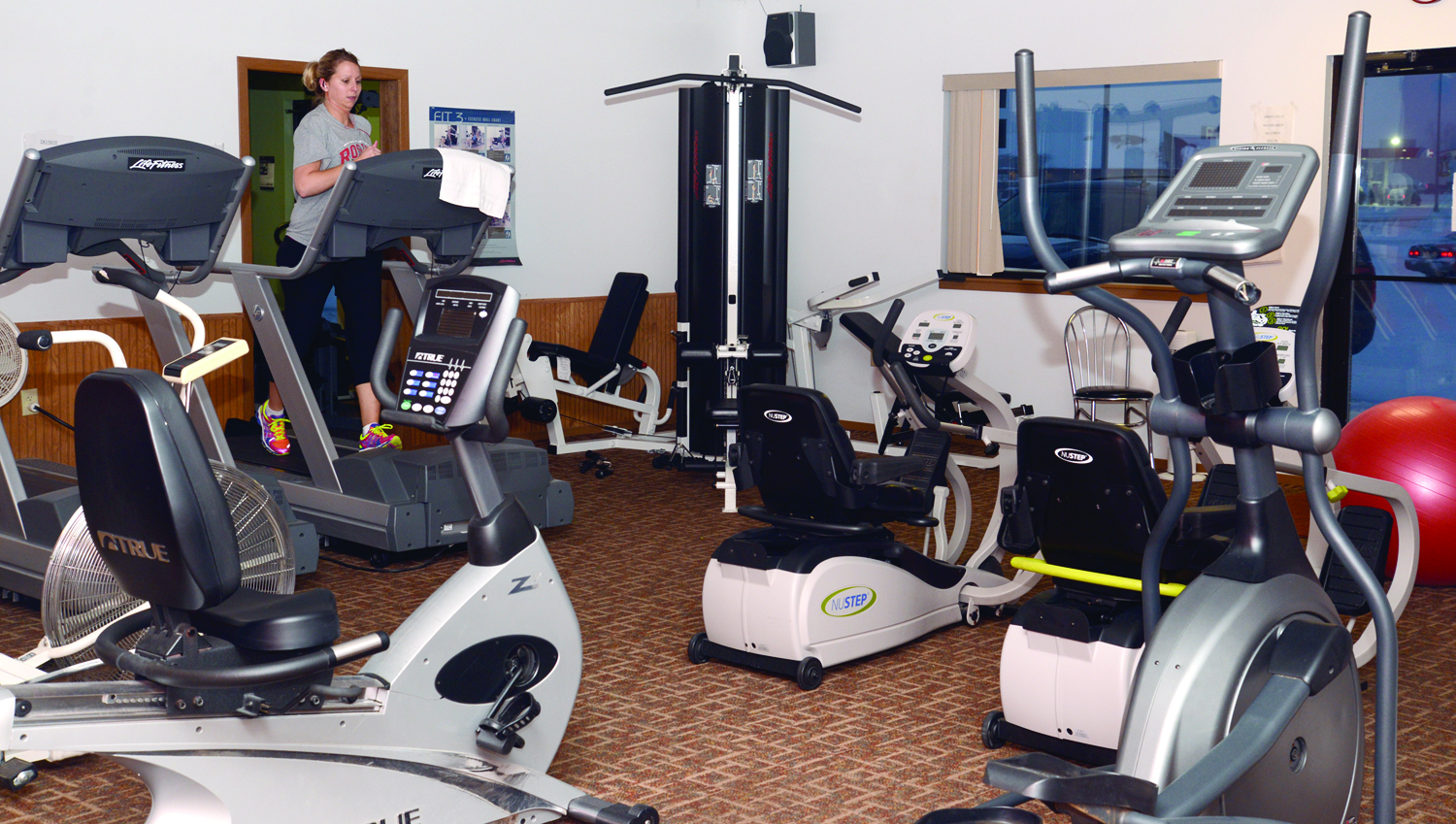By Heidi Marttila-Losure, Dakotafire Media
Reporting by Amanda Fanger, (Webster) Reporter & Farmer; Garrick Moritz, Faulk County Record; Doug Card, Britton Journal; Laura Ptacek, Ipswich Tribune
Rural living allows plenty of space for exercise. But when it’s getting dark at 5 p.m., the wind is blowing, and the temperature stubbornly hangs onto a minus sign, the motivation of even the most dedicated outdoor exercise enthusiast can wane.
Many area communities now offer an option that until a few years ago was only available in larger communities: A place to exercise, with specialized machines and sometimes classes available—and with no hats or long underwear required.
“In rural South Dakota, on days like today (Dec. 4, a day of snow and wind), how else do we exercise?” asks physical therapy assistant Connie Bacon of TLC Fitness Center in Webster. “A 24/7 fitness center provides a safe place to do that.”
[two_third]Webster was one of the first communities in the area to have a fitness center, with a circuit fitness area set up in the office of Kresge Family Chiropractic Clinic in 1996. TLC opened in 1998.
Many other area communities have opened fitness centers in the past decade, including Britton and Bristol in 2004; Frederick in 2007; Ipswich in 2009; Eden, Roslyn and Faulkton in 2010; Veblen in 2011 and Kulm (N.D.) this year.
Recognizing a need
Fitness center employees and organizers say more fitness centers are now open in rural communities in part because individuals increasingly recognize the role of exercise in maintaining good health.
“I think the current generation is seeing more and more how important it is to stay active,” said Austin Sasker, manager of Marshall County Healthcare Wellness Center in Britton. “They have learned from past generations that if you are not out and moving, the later years of your life are going to be more difficult.”
Another factor is the recognition that rural living is no longer as active as it used to be.
Thea Loy Pallansch, a physical therapist with TLC Fitness, said years ago high school football teams were hired by farmer to pick rock and stack square bales—and even further back, people plowed fields with horses, walking in the freshly turned soil all day.
“Those are aerobic exercises! It was all muscle work,” she said, adding that machines now provide the muscle.
Technology has made life easier, but it also means that staying fit requires more of a concerted effort than it has in previous generations.
Statistics suggest many rural Dakotans should be making more of an effort. The 2010 Behavioral Risk Factor Surveillance System, for example, found that North Dakotans in rural areas were more likely to be overweight or obese (65.7 percent) compared to those in metro areas (59.2 percent). Males living in rural areas between the ages of 40 and 84 were found to be particularly at risk: Nearly three out of four men in that category were overweight or obese.
Krege said increasing obesity rates were part of the reason he set up the exercise circuit, a 30-minute workout that includes both cardiovascular and strength components, in his chiropractic office.
“People are not getting healthier,” he said of the statistics.
Finding a way to make it work
Most if not all of the fitness centers in the region started with significant support from the community, and in many cases, partnership with a hospital or school was essential to getting the center off the ground.
The wellness center in Britton is attached to the Marshall County Healthcare Center, which means some of its expenses are shared with the health care center’s expenses. The community also strongly supported the effort: A fund drive took in $1.6 million.[/two_third]
[one_third_last]
Where is it healthier to live: In the city or the country?
A research project in 2011 looked at this question and found that it depends on what factors of health are more important to you. Here’s how the Wall Street Journal reported the story:
“Rural residents are now more likely than other Americans to be obese, sedentary and smoke cigarettes. They also face higher rates of related health problems including diabetes, stroke, heart attacks and high blood pressure.”
On the other hand, city life doesn’t come without its downsides:
“To be sure, city dwellers live with more air pollution and violent crime. They also have higher rates of sexually transmitted diseases and low-birth-weight babies and are more likely to drink excessively. But overall, urbanites tend to rate their own health more highly and are less likely to die prematurely than rural Americans.
In many measures, residents of suburban areas are the best off. They generally rate their own health the highest and have the fewest premature deaths than either their urban or rural counterparts. Suburbanites also have the fewest low-birth-weight babies, homicides and sexually transmitted diseases.” “City vs. Country: Who is Healthier?”, July 12, 2011, Wall Street Journal
Of course, a lot of health is a matter of choice, so geography is not destiny. But the study suggests that more effort is required to fight against the dominant trends of a place. [/one_third_last]
The Wellness & Education Building in Faulkton benefits from being under the ownership of Faulkton Area Medical Center. April Sorenson, FAMC wellness and education coordinator, said the medical center’s support of a place for exercise was essential to getting the project off the ground and supplied as it works to take off.
“Running the program through FAMC—a nonprofit organization—has allowed me to write grants for equipment that would have otherwise been out of reach running the program on my own,” Sorenson said. “Almost all of the equipment we use has been purchased through grant funding and outside donations.”

Another fitness center was also added to the school building in Faulkton, as it was in Frederick. In Frederick, grant funding paid a significant share of the projects’ costs.
In Roslyn and Bristol, the closing of a school provided an opportunity.
“We wanted to try utilizing some of the space in the building,” said Spencer Huggett, coordinator of the Viking Fitness Center in Roslyn. “There’s no doubt—we probably wouldn’t have it if not for the school building being available to us.”
The Ipswich Community Fitness Center got off the ground with the help of the Ipswich’s Development Corporation. Buildings were remodeled with all volunteer labor, and equipment purchases were made with grant money from the Sanford Foundation and the Ipswich Foundation. The plan had always been to “flip” the business, so that an entrepreneur could start with an established business, and recently two exercise enthusiasts and entrepreneurs from Aberdeen, Lori Bruns and Jayme Hoffman, have stepped up to run the business.
“When this opportunity came up for us to run the Ipswich Community Fitness Center, I was very excited, and it seemed silly to pass up the opportunity,” Hoffman said. “It was easy to see that the town was eager for new activities.”
The challenge for fitness centers is that they require a significant upfront cost, a long payback period and a steady stream of customers—which some rural Dakotafire communities cannot easily provide.
Heitmann said The Fitness Factory in Eden—population 87—at one point had 76 members. But since that high point, membership has dropped off. Heitmann suspects that some members were from Roslyn and now, with Roslyn’s new fitness center, work out there.
“The population is too sparse to support a lot here,” Heitmann said.
Without donations or city funding, most small communities couldn’t afford a fitness center, Heitmann said. The only way Eden was able to make it work was because using the existing space in Heitmann’s shop.
In Faulkton, Sorenson said the wellness center sponsored by the FAMC was never intended to be a money-maker.
“We strive to break even,” Sorenson said. “Administration and the Board of Directors view this program to be a service we offer to the community to help improve overall health.”
Other efforts are doing better. Huggett said the Viking Fitness Center needs to have about 35 members to pay its expenses, and now has about 45.
“That’s pretty good for a town the size of Roslyn (with a population about 180),” Huggett said.

Benefits for individuals and communities
The centers have a variety of machines for cardiovascular exercise, and other machines for strength training. Many of the centers also offer something that might be more important: Help in using them.
Pallansch said that employees with TLC Fitness Center, which also offers physical therapy, can craft an exercise program around the individual, especially important if a person has health conditions.
“It’s a place to exercise without feeling intimidated,” Pallansch said.
Jennifer Nelson, another physical therapist at TLC, said fitness centers provided a needed service for senior citizens in the community.
“It seems like these small communities are aging,” Nelson said. “It’s great to have these centers because the senior citizens especially can have a place to go where it’s a safe environment.”
Brad Heitmann said providing a safe space for exercise was his goal in starting The Fitness Factory.
Before the business opened, “I saw a lot of elderly people walking in two-plus feet of snow and slush,” Heitmann said.
Sorensen said a membership to a fitness center can motivate more than simply planning to go for a walk because the membership requires some money to be spent—which most people wouldn’t want to go to waste. Signing up for a class makes a similar commitment of time.
“You make a commitment to be physically active,” Sorenson said. “I often tease that (this reason) is why I teach so many classes. If I don’t schedule myself to teach, then I often don’t get my workout in for the day because I’m pulled in so many different directions.”
The health benefits of exercise are clear: Preventing weight gain or helping with weight loss, fighting chronic diseases like heart disease or diabetes, boosting strength and energy, better sleep, better sex life.
“Health is the genetic expression of lifestyle choices, not genes,” said Dr. Rob Krege, owner of the Krege Family Chiropractic Clinic in Webster. “In other words, how we live—diet and exercise—can potentially have an enormous impact on whether genes of health are expressed, or whether genes of disease and sickness are expressed.”
“I’m pretty passionate about the subject,” Kresge said. “Our life is such a gift. We are supposed to take care of it because our bodies are a temple of the Holy Spirit. I take that seriously.”
The benefits of exercise also show up in a better mood. When Heitmann was in Arizona helping to start a fitness business there, he said, “I just saw the difference in the people. Those who were working out had a better attitude, and were just really enjoyable to be around. Exercise is a wonderful thing.”
These individual benefits spill out into the community as well.
“Exercise increases mood, mental ability and productivity, all of which have had a positive effect on the community,” said Lori Bruns of the Ipswich Community Fitness Center.
A fitness center is also a benefit that communities can promote when recruiting new workers or families.
“It is a great amenity that the community can provide,” Sorenson said. “New people moving into the community often comment about ‘how lucky we are to have these classes in a small town.’”
Connie Bacon, physical therapy assistant at TLC, thinks living in a small community shouldn’t mean living with few amenities.
“Just because you’re in a rural setting doesn’t mean we shouldn’t have everything they have in a big city,” she said.

Leave a Reply